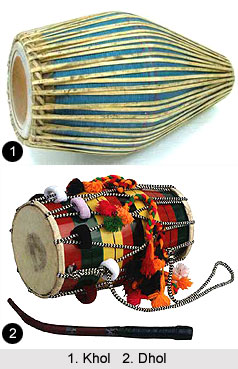 Musical instruments used in folk-songs of the regions of eastern India are limited in number and simple in structure as compared with modern developed specimens. Thus it is important to look into the formative periods. Many researchers and scholars have pointed out that vocal and instrumental music must have existed side by side for a very long time with hardly any mutual connection. So the use of any instruments for folk-music was not essential in the earliest period. Even now a large section of folk-songs is not supported by musical instruments.
Musical instruments used in folk-songs of the regions of eastern India are limited in number and simple in structure as compared with modern developed specimens. Thus it is important to look into the formative periods. Many researchers and scholars have pointed out that vocal and instrumental music must have existed side by side for a very long time with hardly any mutual connection. So the use of any instruments for folk-music was not essential in the earliest period. Even now a large section of folk-songs is not supported by musical instruments.
Musical instruments play a subordinate yet interesting role in folk-music. Independent instrumental music forms a comparatively small part of repertory of most folk groups. Oral folk-music is less valid for instrumental folk-music. Unlike folk-singers the instrumentalist may approach the standing of a professional.
Use of supporting instruments for the entire history of folk-music in India is different in rural areas. The singer himself or the vocal participant in a group is the instrument-player. This relates to general folk-music. In case of party programmes like jatra, some festival songs, pala, kathakata, etc., participating instrument-players have separate entities. It is often found that now-a-days musical instruments used in folk-songs are essential vehicles for carrying folk-music to regional listeners. A number of tribal-songs and folk-songs are named after indigenous musical instruments.
Similar types of instruments are differently named in different areas. Today, a researcher might find it significant to begin with folk musical instruments for observation of musical peculiarities of songs, since scales and variations of tunes are easily detectable through musical instruments and rhythmic instruments help knowledge of the nature and classification of musical forms.
This article is a stub. You can enrich by adding more information to it. Send your Write Up to content@indianetzone.com




















